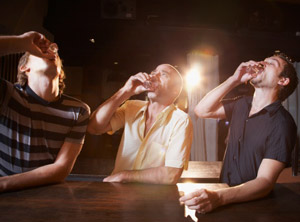Binge drinking
Binge Drinking Consequences
The rapid intoxication that defines binge drinking is linked to a number of seriously negative outcomes for both those who engage in the practice and the public at large. Not surprisingly, binge drinkers consequently have increased risks for getting involved in car crashes, as well as other types of potentially fatal accidents. The swift buildup of alcohol in the bloodstreams of binge drinkers triggers a very real risk for the onset of nonfatal or fatal cases of alcohol poisoning. Other known consequences of the practice include increased risks for exposure to intentional violence, participation in sexually risky behavior, nerve damage, liver damage, and heart and blood vessel disease. All told, the CDC estimates that the U.S. loses hundreds of billions of dollars each year from the social costs of binge drinking and other forms of excessive alcohol consumption.
Which Groups Are Most Likely to Binge Drink?
In the study published in The American Journal of Drug and Alcohol Abuse, researchers from the State of California and Loma Linda University sought to deepen the understanding of the societal groups most likely to participate in binge drinking. To achieve this goal, they compiled information from two years of a statewide project called the California Health Interview Surveys; altogether, data was gathered from 98,662 people. The researchers focused their efforts on the gender breakdown of binge drinking participation, as well as on the racial/ethnic breakdown of participation in this practice. Instead of lumping non-white racial/ethnic groups into multinational categories (Hispanic/Latino, Asian American, etc.), they attempted to break the groups down by nation of origin or region of origin. The researchers found that 31 percent of the men involved in the study reported involvement in binge drinking; in contrast, only 18 percent of the women reported as binge drinkers. For men, the highest rate for the practice (42.9 percent) occurred among individuals of Mexican descent, while the lowest (11.9 percent) occurred among individuals of Chinese descent. For women, the highest rate of binge drinking (25.7 percent) occurred among a diversified group called “Other Latino,” while the lowest (4.8 percent) occurred among individuals of Vietnamese descent. When men and women with the same racial/ethnic background were considered together, individuals classified as white were the most likely to binge drink. However, compared to most other racial/ethnic groups, relatively large numbers of white men and women also binge drank less than once a month.
New Trends Discovered
The authors of the study published in The American Journal of Drug and Alcohol Abuse note that their detailed breakdown of non-white racial/ethnic groups revealed previously unnoticed or underreported trends in binge drinking among specific subgroups of both Hispanic/Latinos and Asians. They believe that this finding highlights the need to provide comprehensive information on the specific racial/ethnic risks for binge drinking participation, as well as comprehensive information on the gender-specific risks for binge drinking.
